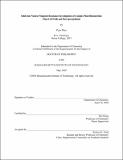Solid-state nuclear magnetic resonance investigations of complex plant biomaterials : plant cell walls and pine sporopollenin
Author(s)
Phyo, Pyae.
Download1192965409-MIT.pdf (32.72Mb)
Other Contributors
Massachusetts Institute of Technology. Department of Chemistry.
Advisor
Mei Hong.
Terms of use
Metadata
Show full item recordAbstract
Plant cell walls offer support and protection to plant cells allowing land plants to thrive all over the world. Growing plant cell wall is a complex system mainly consisting of insoluble polysaccharides: cellulose, hemicellulose and pectin. The cell wall provides both mechanical strength and extensibility to cells via corporative polysaccharide rearrangements. Information on the structures of wall polysaccharides and their reorganization during growth has been elusive due to the lack of high-resolution methods for characterizing this disordered biomaterial. Here, solid-state NMR has been applied to investigate the structure, dynamics and interactions of wall polysaccharides in ¹³C-enriched whole cells and intact cell walls to identify the molecular basics for plant growth. Molecular comparisons between different regions along the elongation gradient of the growing Arabidopsis stem give insights into the structural importance of pectin in wall extension. Our NMR results showed significant decreases in pectin amount, sidechain branching, methylation, polymer hydration, and mobility from the upper to basal regions of the growing stem. 2D ¹³C-¹³C spectra and water-polysaccharides spin diffusion experiments were conducted on the walls of wild-type Arabidopsis and various genetic mutants with different growth phenotypes. Our results showed that weakened cellulose-pectin contact and lower Ca²⁺-mediated HG cross-linking contribute to the polymer slippage underlying cell wall extension and plant growth. Additionally, the reduced HG methylation is suggested to impact these interactions and decrease plant growth. The structural and dynamical heterogeneity of polysaccharides complicate ¹³C NMR spectra. Various dynamics-selective ¹H- and ¹³C-detected correlation experiments conducted under moderate-fast MAS were explored to assign ¹H chemical shifts of intact wall polysaccharides and investigate long-range pectin-cellulose contacts with enhanced spectral resolution and sensitivity. In a separate project, we have determined the structure of natural abundance pine sporopollenin. Sporopollenin is the major component of outer pollen wall and its extreme inertness protects pollens from hostile terrestrial environments. Combining multi-CP for quantitative spectral analysis, spectral editing techniques for assignment of the ¹³C natural abundance material, and biochemical information, we determined the chemical structure of intact sporopollenin. The structure explains the inertness of sporopollenin and gives insight into the biosynthetic pathways and functional properties of this important biopolymer.
Description
Thesis: Ph. D., Massachusetts Institute of Technology, Department of Chemistry, May, 2020 Cataloged from the official PDF of thesis. Includes bibliographical references.
Date issued
2020Department
Massachusetts Institute of Technology. Department of ChemistryPublisher
Massachusetts Institute of Technology
Keywords
Chemistry.